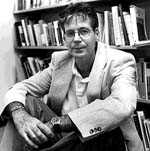|
|
||||||||||
|
Volume
75
|
ECHOES OF THESE GRISLY IMAGES have recurred time and again over the decades, first during the Nazi Holocaust, then in the killing fields of Cambodia, and later in Rwanda and Guatemala, Bosnia and Kosovo.
Though Walter Kalaidjian says he had always been aware of the atrocities that shaped his grandfather’s life, it took a barrage of media images from Africa and the Balkans to jolt him into turning his professional energies toward researching genocide in literature. In doing so, he discovered his grandfather’s writings and an entire genre of literature whose scholarly depths have yet to be plumbed: the literature of third-generation Armenian-American survivors of the genocide. “The story of the Armenian genocide has not had the same kind of impact on the popular imagination that the Holocaust has had. It’s not a widely told story,” says Kalaidjian, whose research until recently focused on twentieth-century American poetry and modernism. “History itself does not always provide an adequate medium for witnessing to extreme events. This is especially true in the Armenian case, where the occasions and rituals of commemorating and mourning the trauma of genocide have been repressed. So literature becomes the medium that records the human truths of the event and supplements the historical record.” Kalaidjian has pieced together accounts of what happened in Turkey all those years ago. This spring, he received a University Research Committee grant that enabled him to acquire fifty videotapes of firsthand survivor testimony. The tapes, from the Zoryan Institute in Cambridge, Massachusetts, became available in Emory’s Special Collections Department this fall and joined a wide range of holdings in the areas of genocide and Holocaust studies. The video testimonies, he says, provide an immediate and troubling encounter with the realities of genocide and mass industrial murder. “It’s difficult material to work with. It’s grim, it’s horrific, it’s eerie. [But] it provides an enormously illuminating context for reading the literature and understanding the persistence and transmission of the trauma of genocide across generations.” NEXT PAGE: As he discusses the Armenian genocide. . . |
|||||||||||||||
